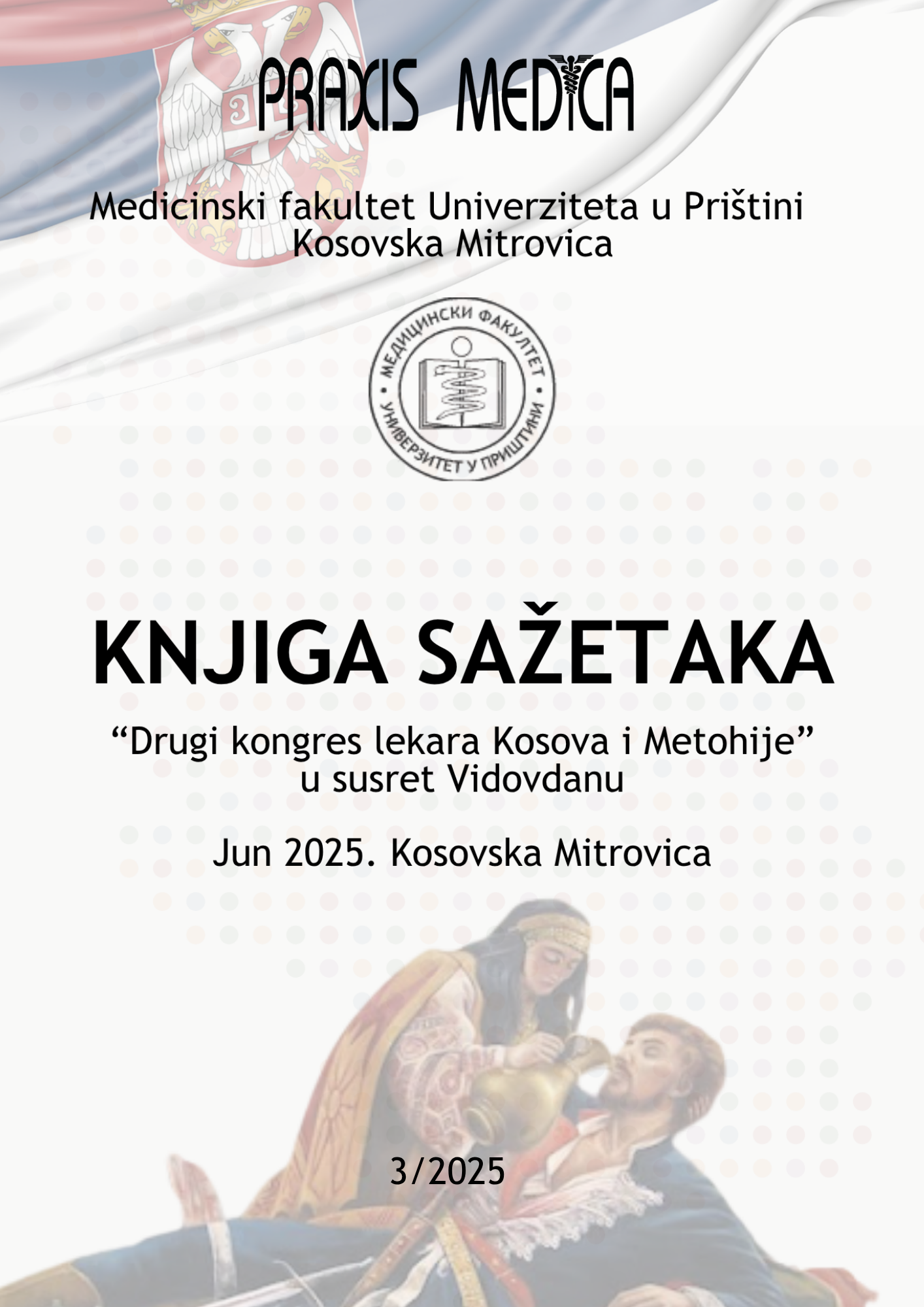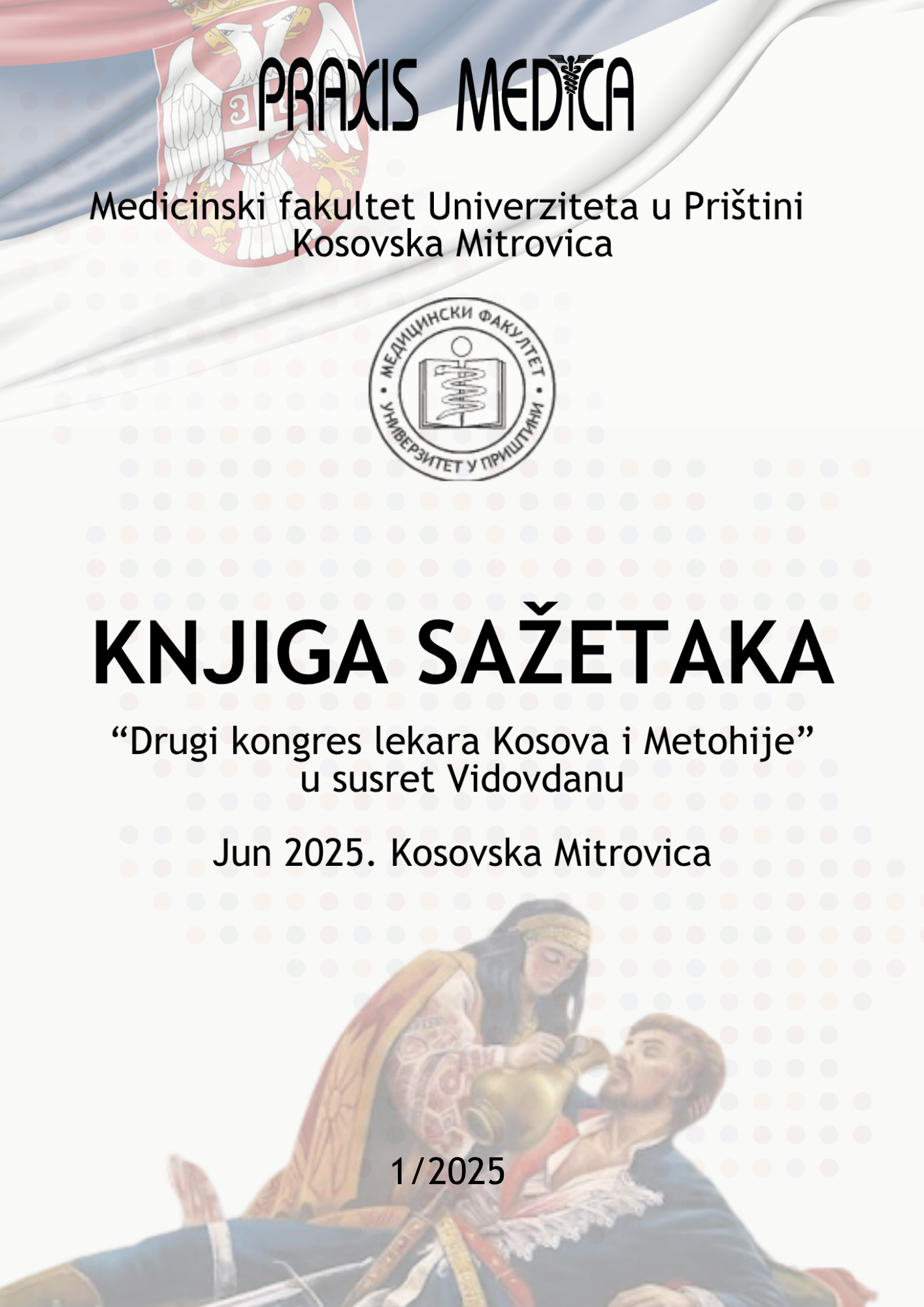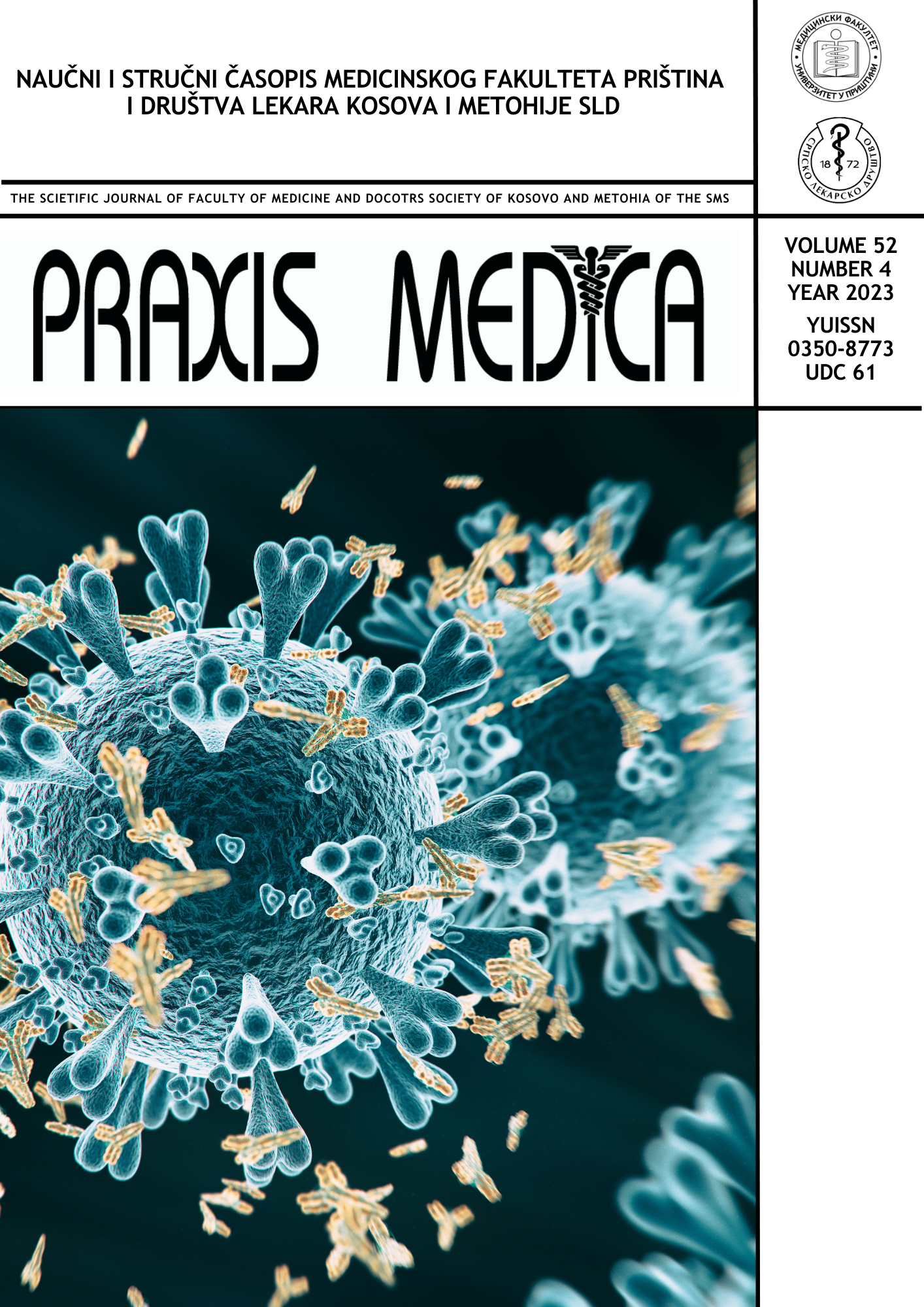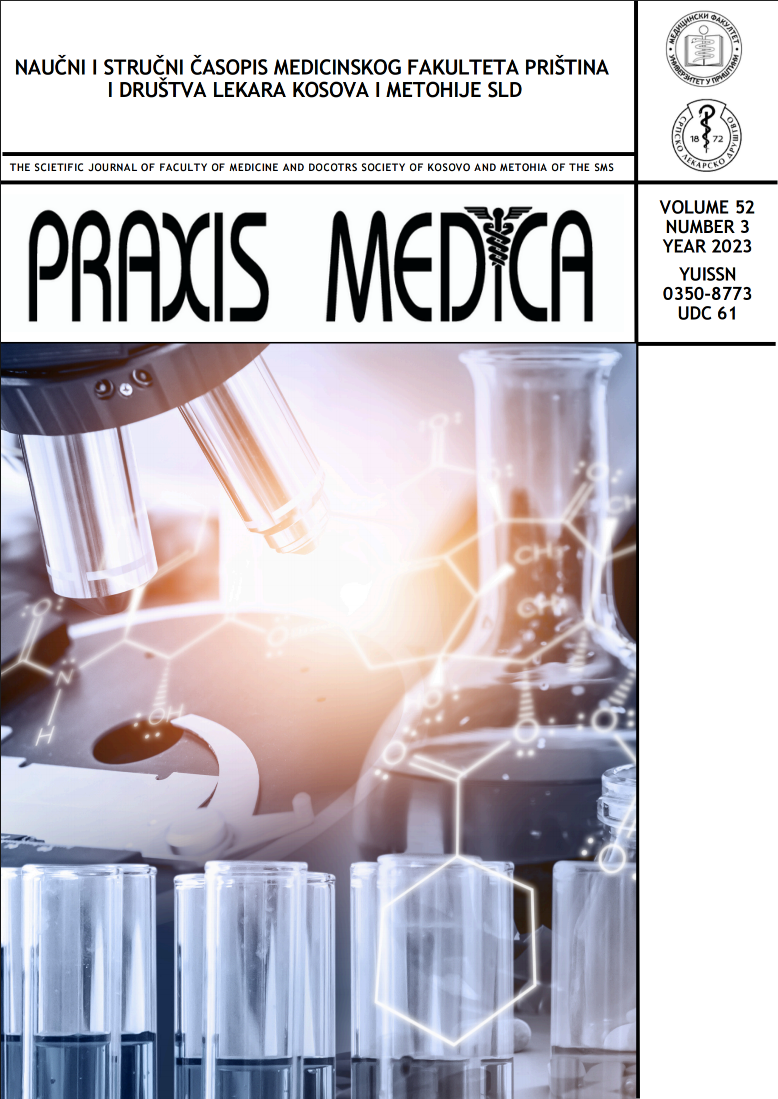Current issue

Volume 53, Issue 4, 2025
Online ISSN: 2560-3310
ISSN: 0350-8773
Volume 53 , Issue 4, (2025)
Published: 30.06.2025.
Open Access
All issues
Contents
01.12.2019.
Science Reports
CRANIOCEREBRAL INJURY COMPLICADET BY BENING CYST OF THE MIDDLE CRANIAL FOSSA
Arachnoid cysts are cavities filled with liquor, usually localized on the floor of the middle cranial fossa. Clinically, they are usually asymptomaticand can sometimes be presented with increased intracranial pressure syndrome and epileptic seizures. We present a patient who, after a slight head injury in a accident develops an increased intracranial pressure syndrome followed by an epileptic seizure. Based on the clinical course and diagnostic processing, we want to draw attention doctors who are in a position to inspect these patients that apparently slight head injuries can be complicated and dangerous for the lives of the premorbid intracranial condition of the injured.
Vekoslav Mitrović, Radmil Marić, Sanja Marić, Miroslav Obrenović, Vjeran Saratlić, Ivo Berisavac
01.12.2019.
Professional paper
RISK FACTORS FOR POSTPARTUM DEPRESSION IN THE EARLY POSTPARTUM PERIOD
Introduction: Some psychosociodemographic and characteristics of pregnancy and childbirth have been associated with
the onset of postpartum depression in the literature.
Aim: To examine certain psychosociodemographic and characteristics of pregnancy and childbirth as potential risk factors
for the onset of postpartum depression in the early postpartum period. Material and Methods: The study involved 120 subjects, which included the use of the Edinburgh Postpartum Depression Scale and a sociodemographic questionnaire constructed for the purposes of this study, in the early postpartum period.
Results: Of the total 92 (76.7%) subjects were not depressed, while 28 (23.3%) had depression. The high risk of postpartum depression correlates with: postpartum weight gain, subjective experience of lack of freedom, fear that she would be abandoned (p <0.05), as well as having frequent quarrels, mentioning a divorce or divorce, and a temporary separation, poor relationship with the parents on both sides and poor general family atmosphere (p <0.001). A statistically significant risk of depression was also found in the group with complications during childbirth, unplanned pregnancy (p <0.001), as well as alcohol and cigarette consumption during pregnancy (p <0.05).
Conclusion: The risk of postpartum depression can be detected by applying the EPDS scale in the early postpartum period. Early detection of potential risk factors can significantly prevent the onset of postpartum depression and significantly affect the central psychological process in the postpartum period, which is related to the development of an emotional relationship between mother and child.
Jelena Stojanov, Aleksandar Stojanov, Miodrag Stanković
01.12.2019.
Case Reports
VESTIBULAR NERVE SCHWANNOMA, TREATED WITH GAMMA KNIFE AND DIAGNOSED AFTER TRANSITORY ISCHEMIC ATTACK IN POSTERIOR CEREBRAL VASCULARISATION
A case of a patient is shown, who was admitted for neurological exploration, with clinical manifestations of the cerebrovascular accident in the posterior circulation (TIA V-B vascularisation). In accordance with diagnostic protocol, an endocranial CT was performed. The results of the brain CT indicated an existence of an alteration in the right pontocerebellar angle area, which was subsequently diagnosed as a n. vestibularis schwannoma in an NMR examination. After a neurosurgical deliberation, the patient was treated with a gamma knife. After this surgery, which was done in a local anesthesia, the patient's condition was well and he was discharged. Control examinations have shown minor difficulties during the stimulation of the left ear auditive structures. Control examinations involving NMR showed no signs of recidivate focal findings.
Snežana Filipović Danić, Vekoslav Mitrović, Boban Biševac, Nenad Milošević, Jelena Dančetović
01.12.2019.
Case Reports
RARE MALPOSITION OF CENTRAL VENOUS CATHETER
Introduction:Although placement of the central venous catheter is a routine procedure carried out by anesthesiologists, it
carries a certain risk of complications. One of the complications is malposition, or inadequate catheter position.
Case report: We present a case of the patient who was admitted to an intensive care unit due to head injury and blood
vomiting. The central venous catheter was inserted through the right internal jugular vein. Due to haemodynamic instability and the need for fluid and blood infusion, a chest x-ray examination was not immediately performed to evaluate the position of the catheter. After the patient was stabilized, the test was performed and revealed that the tip of the catheter was not located in the superior vena cava but in the right subclavian vein.
Conclusion: This case has shown that the misplacement of the central venous catheter tip is not unusual. Once in the venous system, even when it is not located in the superior vena cava, it can be used for initial fluid replacement and drug administration, and after the patient is stabilized, the repositioning or placement of a new catheter should be considered.
Nebojša Videnović, Bojan Stojičević, Ranko Zdravkovic, Jovan Mladenovic
01.12.2019.
Case Reports
ROLE OF GENERAL PRACTICE DOCTOR IN THE TREATMENT OF SIGNET RING CELL CARCINOMA
Introduction: Stomach cancer is the second in mortality and the fourth most frequent of all cancers in the world. In the recent decades, the number of patients with Signet ring cell carcinoma type has been growing. Unknown etiology with proven risk factors such as smoked and salted foods, smoking, metabolic syndrome, alcohol abuse and Helicobacter pylori infection. Five-year span survival is 20%-40%.
Case outline: Patient, 70 years old, in good health, came to the GP, because of pain she had been feeling in the lower back area for a couple of months. Sometimes she wakes up because of the pain below the chest. Belch, acid, lost three kilograms. Didn't pay any attention to the problem because earlier, due to severe osteoporosis, she had obtained a compression fracture of two vertebrae. Occult bleeding negative. Laboratory normal. Tenderness on palpation of epigastrium, the tumor mass is not palpable. Addressed immediate to esophagogastroduodenoscopy. Diagnosis: Ulcer ventriculi, region antrum. Histopathological findings: Gastric Adenocarcinoma, diffuse type, Signet ring cell. Computed tomography showed locoregional lymphadenopathy so responsible Consilium decided radical surgery and chemotherapy. Despite being treated, the patient pass away two years after the onset of the illness.
Conclusion: Primary health care workers have a big responsibility, because of nonspecific symptoms, in detection of gastric cancer. Good evaluation of patients who should be referred for esophagogastroduodenoscopy is essential. The doctor should keep in mind in the further course of treatment early postoperative complications, Dumping syndrome, appears ventral anastomosis, subocclusive disorders, gallbladders calculus formation, educate patients about nutrition, vitamins, monitor vitamin B12 and iron because patients are prone to vitamin deficiency and pernicious anemia. Psychological support for patients and their families is also very significant, through a concrete doctor-patient relationship.
Snežana Knežević B., Ivan Gajović Z., Ljiljana Đurović
01.12.2019.
Original scientific paper
EXAMINATION OF THE IMPACT OF CHARACTERISTICS OF THE HEALTH ISSUES, LENGTH OF TIME SINCE THEMYOCARDIAL INFARCTION AND COMORBIDITY TO THE QUALITY OF LIFE OF DISEASED OF MYOCARDIAL INFARCTION
Introduction: Acute myocardial infarction is a common and urgent disease with potentially poor prognosis, so the examination of the quality of life of diseased and all factors that affect it are very important. Objective of the paper is to examine the impact of the characteristics of the health issues, thelength of time since the myocardial infarction as well as the comorbidity to the quality of life of diseased of myocardial infarction.
Methods: In order to assess the impact of acute myocardial infarction on the quality of life of diseased, a retrospectiveprospective study was conducted, designed as a cross sectional study. The followingwas used during the research: sociodemographic questionnaire, questionnaire for assessment of health status, comorbidity and characteristics of health issues of patients and Short Form 36 Health Survey, i.e. SF-36. Statistical analysis of data was made using the SPSS software statistical program.
Results: The study covered 175 subjects, of which 113 (64.6%) were male and 62 (35.4%) female. In relation to the time of diagnosis of AMI in 29.7% of subjects, the diagnosis was set in the last month, while in the remaining 70.3% it was diagnosed in the last year to a month. The highest number of respondents (68.6%) felt a strong pain before reporting to a healthinstitution for treatment, 63.4% of the respondents had cardiovascular comorbidity and the highest number of respondents (83.4%) has diagnosed arterial hypertension. Physical functioning (65.48: 81.42) (t = -6.841; p = 0.001), limitation due to physical health (51.44: 76.62) (t = -7.364; p = 0.001), the presence of bodily pains (35.88: 57.05) (t = - 7.943; p = 0.001), general health (59.04: 75.75) (t = -7.277; p = 0,001), vitality (52.78: 56.99) (t = -4.796; p = 0.001), social functioning (39.42: 63.31) (t = -7.099; p = 0.001), limitation due to emotional problems (33.97: 61.51) = -6.693; p = 0.001) and mental health (36.69: 53.97) (t = -7.714; p = 0.001) are domains in which there is a high statistically significant difference in mean values between groups of subjects compared to the time of diagnosis, whereby respondents which diagnosis was set in the last year to a month have statistically significantly better quality of health compared to those which diagnosis was set in the last month. When it comes to a common measure of physical health and mental health, a group of subjects diagnosed in the last year to a month also showed statistically significantly better results than respondents in whom AMI diagnosis was found in the last month (t = -4.152; p = 0.001; t = -7.147; p = 0.001).
Discussion: The quality of life related to health is significantly lower in subjects diagnosed with AMI in the last month compared to respondents who have been diagnosed in the last year to a month and between groups of subjects of different sexes there is no statistically significant difference in any of the quality life domains related to health. When it comes to the age of respondents, HRQOL is significantly higher in all domains of physical and mental health in the younger group of respondents.
Conclusion: Myocardial infarction affects the quality of life of the diseased,which is significantly better in the younger age group compared to the older respondents, and does not differ in relation to gender. The quality of life of patients with myocardial infarction differs in relation to the time since myocardial infarction and those diagnosed with AMIduring the reception to the hospital in the last month have significantly lower quality of life compared to subjects with AMI diagnosed in the last year to a month. The quality of life of patients with myocardial infarction is worse if the health issues are more expressed and there is comorbidity.
Ljiljana Kulić, Milica Vujović
01.12.2017.
Professional paper
Hiperinsulinemia and ketotic hypoglycemia as the most common forms of hypoglycemic states in childhood
Snežana Marković-Jovanović, Aleksandar Jovanović, Dragica Odalović, Jadranka Mitić, Vanja Nikčević, Perić Vladan
01.12.2017.
Professional paper
Histological analysis of tissue of the interdental space before and after correction of irregular fillings: Experimenting on animals
Dušan Živković, Milan Živković, Milan Miladinović, Zorana Veličković, Dejan Perić, Radovan Jovanović, Miloš Staletović, Raša Mladenović
01.12.2017.
Professional paper
Precision of Moyers table values of predicting C-P2 segment applicable to our population
Amila Vujačić, Vladanka Vukićević, Sanja Simić











